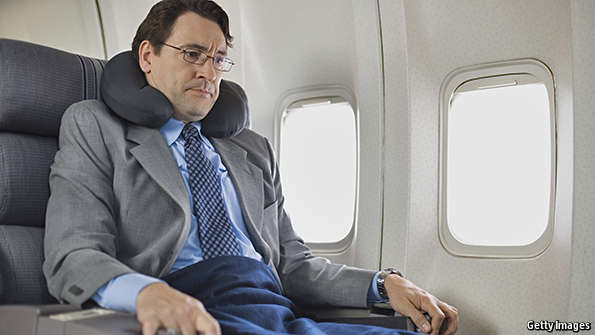This article originally appeared in the Economist
The Sad, Sick Life of the Business Traveller
MANY of us have found ourselves trying to explain to friends and colleagues that, no, business travel isn’t as fun and glamorous as it seems. Finally, there could be proof to back this up. Researchers at the University of Surrey, in Britain, and Linnaeus University, in Sweden, have published a new study highlighting what they call “a darker side of hypermobility”. The “hypermobile”—largely but not exclusively business travellers—have won a certain cachet in contemporary society, with the worldliness they seem to acquire from their travels and the envy-inducing social-media posts they leave in their wake. But, the researchers warn, “whilst aspects of glamorisation in regard to mobility are omnipresent in our lives, there exists an ominous silence with regard to its darker side”.
The study, which synthesises existing research on the effects of frequent travel, finds three types of consequence: physiological, psychological and emotional, and social. The physiological ones are the most obvious. Jet lag is the affliction travellers know best, although they may not anticipate some of its direr, if rarer, potential effects, like speeding ageing or increasing the risk of heart attack and stroke. Then there’s the danger of deep-vein thrombosis, exposure to germs and radiation—people who fly more than 85,000 miles a year (say, New York to Seattle and back every three weeks, or New York to Tokyo and back seven times) exceed the regulatory limit for exposure to radiation. And finally, of course, business travellers tend to get less exercise and eat less healthily than people who stay in place.
The psychological and emotional toll of business travel is more abstract, but just as real. Frequent flyers experience “travel disorientation” from changing places and time zones so often. They also suffer mounting stress, given that “time spent travelling will rarely be offset through a reduced workload, and that there may be anxieties associated with work continuing to accumulate (eg ‘inbox overload’) whilst away”. Due to the absence from family and friends, “hypermobility is frequently an isolating and lonely experience,” the authors write. The accumulated impact can be substantial. One study of 10,000 World Bank employees found that the business travellers among them were three times as likely to file psychological insurance claims.
Finally, there are the social effects. Marriages suffer from the time apart, as does children’s behaviour. What is more, relationships tend to become more unequal, as the partner who stays at home is forced to take on more domestic duties. There’s a gender disparity here, since most business travellers are men. (A 2011 survey of Asian business travellers by Accor, a hotel firm, found that 74% were men. Seemingly the last comprehensive research into American business travellers in 2002 found that 77% were male.) Friendships also fray, as business travellers often “sacrifice local collective activities and instead prioritise their immediate families when returning from trips”.
Of course, these impacts are mitigated by the fact that they fall disproportionately on a segment of the population that is already doing rather well. The “mobile elite” tend to have higher incomes and access to better health care than the population at large. According to the study, in Sweden, 3% of the population accounts for a quarter of international travel; in France, 5% covers half of the population’s total distance travelled.
So these may be problems of the 1% (or the 3%, or the 5%). But they’re real enough regardless. By all means feel jealous of acquaintances’ Instagram photos of exotic meals and faraway attractions. But harbour a small amount of concern as well.

 Save up to 60% on Business Class. Call 1-800-435-8776
Save up to 60% on Business Class. Call 1-800-435-8776

Leave A Comment